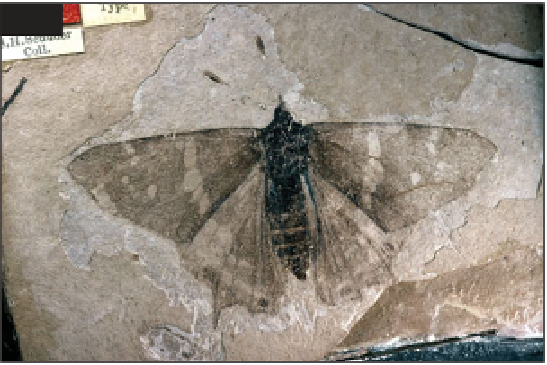Geoscience Reference
In-Depth Information
twentieth century and his lifelong interest
in fossil insects was sparked when he
was shown the unique Florissant fossil
butterfly
little town of Morrison near Denver, is
famous (Chapter 9). At the end of the
Mesozoic Era, as the dinosaurs were
becoming extinct, a new mountain-
building episode, the Laramide Orogeny,
was creating the vast Rocky Mountains
we see today. The mountains were
being built from the west to the east, and
ripples spread towards Colorado from
the Pacific. The Front Range forms the
easternmost effect of the Laramide
Orogeny, and the Pikes Peak granite,
formed deep inside the crust billions of
years previously, was forced upwards and
exposed as its soft cover rocks were
eroded away.
Major north-south trending folds and
faults were selectively eroded during and
following the Laramide Orogeny, and in
its later stages, explosive volcanism, such as
we see today in the Cascades of northern
California, Oregon, and Washington,
developed in the South Park area. In late
Eocene times, around 35 Ma, the Florissant
Valley held a river system that was carrying
sediment eroded from the surrounding
mountains, made of Paleozoic and
Mesozoic rocks folded over a Pikes Peak
granite core. The strata at Florissant record
the first volcanic eruption: a destructive
Prodryas persephone
(
218
)
(Grimaldi and Engel, 2005).
S
TRATIGRAPHIC SETTING AND
TAPHONOMY OF
F
LORISSANT
The soft rocks of the late Eocene
Florissant Formation, which underlie
the Florissant Valley, contrast dramatically
with the ancient granite of the nearby lofty
Pikes Peak which, at 4301 m (14,110 ft), is
the highest mountain in the Front Range.
The Pikes Peak granite was intruded into
metamorphic gneiss and schists during a
mountain-building episode (orogeny)
more than 1000 million years ago, in the
Precambrian. For many millions of years
these ancient mountains were eroded,
and the resulting sediment was deposited
in the adjacent seas throughout the lower
Paleozoic Era. Another mountain-
building period, the Colorado Orogeny,
occurred in the Pennsylvanian Period,
and renewed erosion followed. During
the Mesozoic Era, the area east of the
mountains formed a broad land area
which was roamed by dinosaurs for which
the Morrison Formation, named after the
218
218 The magnificent fossil
butterfly Prodryas persephone
MCZ. Wingspan 52 mm 2 in.




Search WWH ::

Custom Search